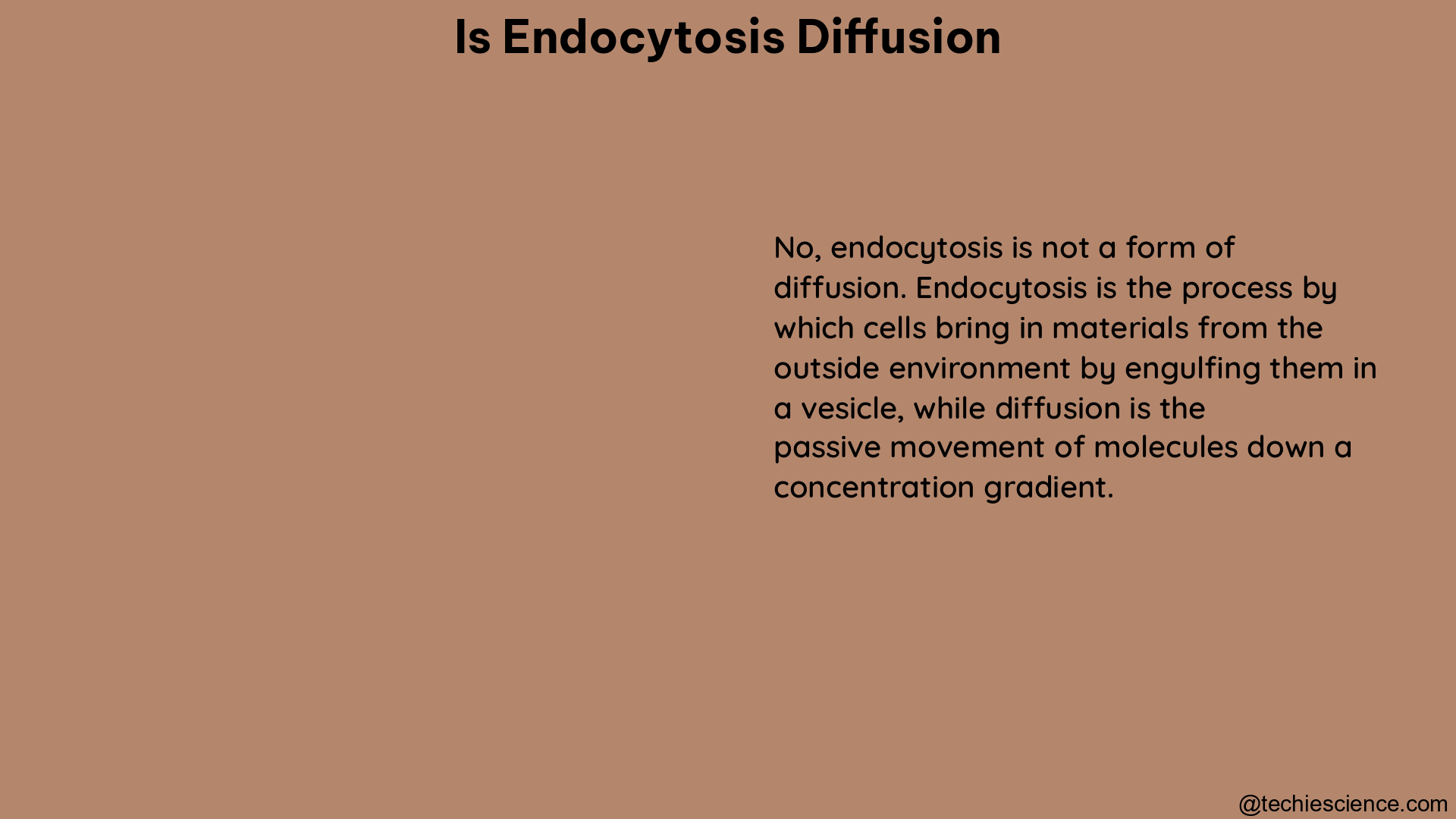Summary
Endocytosis and diffusion are two fundamental processes in biology that govern the movement of particles and molecules across cell membranes. While endocytosis involves the active uptake of large molecules, particles, and even other cells through the inward budding of the cell membrane, diffusion is the passive movement of small, uncharged molecules and ions from areas of high concentration to areas of low concentration. This comprehensive guide delves into the intricate details of these processes, providing a deep understanding of their mechanisms, quantifiable data, and their crucial roles in maintaining cellular homeostasis and regulating various cellular functions.
Understanding Endocytosis

Endocytosis is a complex process that can be further classified into several subtypes, each with its own unique characteristics and mechanisms:
- Phagocytosis: The engulfment of large particles, such as bacteria or cellular debris, by specialized cells like macrophages and neutrophils.
- Pinocytosis: The uptake of extracellular fluids and dissolved molecules through the formation of small vesicles.
- Receptor-mediated endocytosis: The selective uptake of specific molecules, such as hormones or growth factors, through the binding of these molecules to specific receptors on the cell surface.
- Clathrin-mediated endocytosis: A well-studied form of receptor-mediated endocytosis that involves the formation of clathrin-coated pits on the cell membrane, which then pinch off to form vesicles.
The rate of endocytosis can be quantified by measuring the number of vesicles formed per unit time, which can range from a few vesicles per minute to hundreds of vesicles per minute, depending on the cell type and the specific endocytic pathway involved. Additionally, the size and volume of the vesicles can be measured, with typical diameters ranging from 60 to 200 nanometers. The concentration of the ingested material within the vesicles can also be quantified, providing insights into the efficiency of the endocytic process.
Understanding Diffusion
Diffusion is the passive movement of particles, molecules, and ions from an area of high concentration to an area of low concentration. This process is driven by the random thermal motion of the particles and is governed by Fick’s laws of diffusion. The rate of diffusion can be quantified by the diffusion coefficient, which describes how quickly particles move through a given volume over time.
The diffusion coefficient can be determined experimentally by measuring the movement of particles over time and fitting the data to a mathematical model. Typical diffusion coefficients for small molecules in aqueous solutions range from 10^-9 to 10^-5 square centimeters per second, depending on the size and charge of the molecule.
Diffusion plays a crucial role in the exchange of molecules and ions between the extracellular environment and the cytoplasm, as well as between different intracellular compartments. This process allows for the rapid and efficient movement of essential nutrients, gases, and signaling molecules, ensuring the proper functioning of cellular processes.
Theoretical Underpinnings of Endocytosis and Diffusion
To better understand the mechanisms underlying endocytosis and diffusion, it is important to consider the following key concepts and models:
Endocytosis
- Membrane Bending and Scission: The formation of vesicles during endocytosis can be described using the model of membrane bending and scission. This process involves the recruitment of specific protein complexes, such as clathrin and adaptor proteins, to the cell membrane, which induce curvature and promote the formation of a vesicle.
- Rab GTPases: These small regulatory proteins play a crucial role in the various stages of endocytosis, including vesicle formation, trafficking, and fusion with target organelles.
- Actin Cytoskeleton: The actin cytoskeleton provides the necessary mechanical support and dynamics for the formation and movement of endocytic vesicles.
Diffusion
- Brownian Motion: The movement of particles during diffusion can be described using the model of Brownian motion, which assumes that particles move randomly due to collisions with surrounding molecules.
- Fick’s Laws of Diffusion: These laws describe the quantitative relationship between the flux of particles and the concentration gradient driving the diffusion process.
- Membrane Permeability: The rate of diffusion across cell membranes is influenced by the permeability of the membrane, which is determined by the presence and properties of specific membrane channels and transporters.
Biological Significance of Endocytosis and Diffusion
Endocytosis and diffusion play crucial roles in maintaining cellular homeostasis and regulating various cellular processes:
- Nutrient Uptake: Endocytosis is essential for the uptake of nutrients, such as proteins, lipids, and carbohydrates, which are necessary for cellular growth and metabolism.
- Waste Removal: Endocytosis facilitates the removal of waste products and cellular debris, ensuring the proper functioning of the cell.
- Signaling Molecule Internalization: Endocytosis is involved in the internalization of signaling molecules, such as hormones and growth factors, which are essential for cellular communication and regulation.
- Ion and Molecule Exchange: Diffusion allows for the rapid and efficient exchange of small molecules and ions, such as oxygen, carbon dioxide, and nitrogen, between the extracellular environment and the cytoplasm, as well as between different intracellular compartments.
- Cellular Homeostasis: The coordinated regulation of endocytosis and diffusion is crucial for maintaining cellular homeostasis, ensuring the proper balance of nutrients, waste products, and signaling molecules within the cell.
Conclusion
Endocytosis and diffusion are two fundamental processes in biology that play a crucial role in the movement of particles and molecules across cell membranes. Understanding the mechanisms, quantifiable data, and theoretical underpinnings of these processes is essential for a comprehensive understanding of cellular function and regulation. This guide has provided a detailed exploration of these topics, equipping you with the knowledge and tools necessary to delve deeper into the fascinating world of cellular biology.
References
- Endocytosis and Signaling: Cell Logistics Shape the Eukaryotic Cell Plan. (n.d.). Retrieved from https://www.ncbi.nlm.nih.gov/pmc/articles/PMC5614474/
- Vesicle and reaction-diffusion hybrid modeling with STEPS. (n.d.). Retrieved from https://www.nature.com/articles/s42003-024-06276-5
- Membrane Transport – BIOLOGY FOR LIFE. (n.d.). Retrieved from https://www.biologyforlife.com/14-membrane-transport.html

Hello, I am Piyali Das, pursuing my Post Graduation in Zoology from Calcutta University. I am very passionate on Academic Article writing. My aim is to explain complex things in simple way through my writings for the readers.